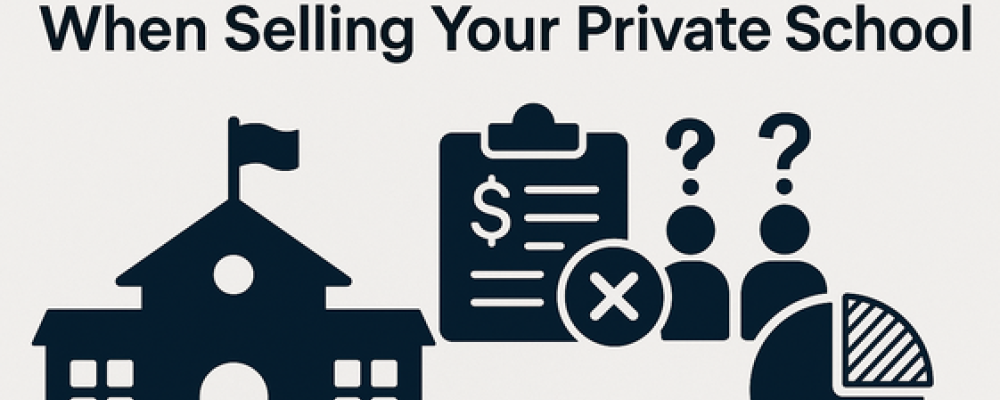
Selling a private school represents one of the most significant business and personal decisions an owner will ever make. It’s not just about transferring ownership—it’s about safeguarding a legacy, protecting staff and student continuity, and ensuring the institution thrives long after the sale. Yet many school owners approach this process without adequate preparation or guidance, leading to undervaluation, prolonged negotiations, and, in some cases, failed transactions.
Over more than four decades of operational leadership and M&A advisory in the education sector, Halladay Education Group has facilitated the successful sale of private K-12 schools, boarding schools, colleges, and universities across Canada and the United States. Through this experience, we’ve identified the most common pitfalls that can derail even well-intentioned sales—and the strategies that consistently lead to premium valuations and smooth closings.
This comprehensive guide outlines the most frequent private school sale mistakes, why they happen, their impact on deal value, and how to avoid them.
1. Inadequate Financial Documentation and Record Keeping
The Critical Error:
Entering the market without complete, accurate, and professionally prepared financials is the single most damaging mistake school owners make. This includes audited or reviewed financial statements, enrollment data, tuition revenue breakdowns, expense classifications, and forward-looking budgets.
Strategic Impact:
Sophisticated buyers—whether private equity groups, school chains, or high-net-worth individuals—make decisions based on hard data. Disorganized records raise questions about governance, operational discipline, and risk. In competitive sales processes, incomplete documentation can eliminate a school from contention before negotiations even begin.
Best Practice:
Engage a qualified accountant with M&A experience at least 12–18 months before marketing your school. Ensure you can produce at least three years of clean, reconciled financial statements along with enrollment trends, attrition rates, and other operational KPIs.
2. Flawed Valuation Methodology and Market Positioning
The Critical Error:
Owners often anchor their school’s value to emotional investment or replacement cost, rather than market realities. Conversely, some undervalue their school due to unfamiliarity with current private school M&A valuations.
Strategic Impact:
Overpricing stalls momentum and can brand a listing as “shopworn,” while underpricing leaves substantial value on the table. Either scenario weakens negotiating leverage.
Best Practice:
Use a sector-specific valuation approach incorporating EBITDA multiples from recent comparable transactions, regional market trends, enrollment mix (domestic vs. international), and program reputation. HEG’s proprietary transaction database ensures valuations are market-accurate and defensible.
3. Premature Disclosure and Confidentiality Breaches
The Critical Error:
Announcing the sale before securing confidentiality agreements or a process framework creates instability among staff, parents, and the wider community.
Strategic Impact:
Early disclosure often leads to uncertainty that can trigger staff turnover, enrollment declines, and reputational damage—each of which can directly reduce valuation.
Best Practice:
Enforce strict confidentiality protocols from day one. Information should only be shared with pre-qualified buyers under signed NDAs. Communications should be staged and controlled, with messaging carefully crafted for different stakeholders.
4. Inadequate Buyer Qualification and Due Diligence
The Critical Error:
Responding to every expression of interest without vetting prospective buyers for financial capacity, operational experience, and cultural alignment.
Strategic Impact:
Engaging unqualified buyers wastes management time, creates false momentum, and exposes sensitive data to parties who cannot close.
Best Practice:
Work with an intermediary who maintains a vetted network of institutional and strategic buyers. Screening should include proof of funds, acquisition track record, and alignment with the school’s values and mission.
5. Regulatory Compliance and Legal Preparedness Gaps
The Critical Error:
Failing to address licensing renewals, accreditation status, or legal compliance before going to market.
Strategic Impact:
Regulatory issues discovered late in due diligence can delay closing, lower the purchase price, or terminate the transaction entirely.
Best Practice:
Conduct a compliance audit months in advance. Confirm all regulatory filings, accreditations, employment contracts, and corporate documents are current and in order.
6. Ineffective Marketing Strategy and Limited Buyer Outreach
The Critical Error:
Relying on generic business brokers or limited advertising channels to market a school.
Strategic Impact:
This reduces competitive tension and limits exposure to serious buyers, often resulting in lower offers.
Best Practice:
Develop a professional marketing package—a confidential information memorandum (CIM)—that highlights the school’s unique programs, market position, and growth potential. Use targeted outreach to qualified domestic and international buyers.
7. Insufficient Transition and Succession Planning
The Critical Error:
Not addressing leadership continuity or operational transition before the sale process begins.
Strategic Impact:
Uncertainty around post-sale leadership can spook buyers, lower offers, and increase their perceived risk.
Best Practice:
Create a clear transition plan, including staff retention strategies, operational handover timelines, and parent communications, to reassure both buyers and stakeholders.
8. Lack of Market Analysis and Competitive Intelligence
The Critical Error:
Entering the market without a deep understanding of competitive dynamics, enrollment demand, and demographic shifts.
Strategic Impact:
Weak market intelligence can lead to suboptimal timing, poor positioning, and misaligned pricing.
Best Practice:
Commission a market analysis that includes competitor benchmarking, demographic projections, and sector trends to inform your sales strategy.
How Halladay Education Group Mitigates These Risks
Our role as specialized private school M&A advisors is to address every risk before it becomes a barrier to closing. We provide:
Market-Accurate Valuations backed by decades of transaction data
Controlled, Confidential Processes to protect staff, enrollment, and brand reputation
Access to Qualified Buyers from our proprietary network
Regulatory and Legal Readiness audits before market launch
Seamless Transition Planning to maintain stability during ownership change
Final Word
Selling a private school in Canada or the United States is a complex, high-stakes process. Avoiding these mistakes requires preparation, precision, and professional guidance. By engaging a specialized advisor early, owners can protect their legacy while achieving maximum value.
For a confidential consultation on your school’s market position and sale readiness, contact Halladay Education Group today.